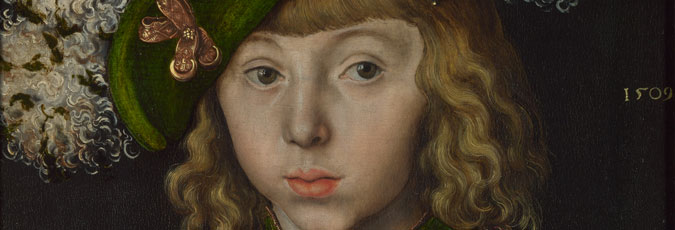Technical notes
Conservation
The paintings were cleaned and restored in 1995.
Condition
The panels and frames have suffered worm damage, but are otherwise in good condition. The dull yellow paint on the frames is the exposed mordant or adhesive for the original gilding; only traces of gold leaf remain. The paint of NG6538 is in excellent condition, with only a few tiny flake losses. There may be some fading of a red lake pigment in the flesh paint of the sitter’s hands. NG6539 has more small losses, from the green paint of the sitter’s costume, along the grain of the wood, but is still in very good condition.
Materials and technique
The frames are original. The profiles, with their simple deep scotia moulding and raised outer edge enriched with a narrow half round, are similar to those found on other frames of works by Cranach of this period.5 They are joined with a double mortise and tenon joint.6 It can be seen in X-ray images that neither frame fits the panel exactly: there are gaps top and bottom, although the frames fit tightly on the left and right; however, this can be explained by the natural contraction across the grain of the panels, and is not any indication that the portraits were not originally in these frames.
The outer edges and the backs of the frames are painted black. The inner mouldings were originally gilded although what is now visible is mainly the golden-yellow oil mordant (adhesive)7, and only fragments of the gold leaf remain. Traces of this mordant pass beneath the black background on NG6539 confirming that it is original and was already in place when the background was painted. On NG6538 there are traces of the original final translucent green paint of the background on the gold, indicating that it was applied when the frames were complete. However, painting of the portraits and decoration of the frames were probably carried out concurrently, since there are also traces of gold from the frame on top of the black background of NG6539 at the left edge The frames are joined with iron hinges and handmade iron nails; this was done after gilding as the tips of the nails are visible in the mouldings.8
The panels are each formed from three thin boards of wood with grain running horizontally.
The backs of both panels are painted black. On NG6538 there is a later inscription in red which reads N27 28. Two shields are painted on the back of NG6539 (see below).
The grounds of the obverses are of chalk. The reverses are painted directly on to the wood with no ground. There does not appear to be any priming. Nothing that could be definitely identified as underdrawing was found with infrared reflectography.
The medium of the paint of the green background and black robe in NG6538, and of the green sleeve in NG6539, was identified by GC–MS analysis as linseed oil.9 A sample of red paint from the pattern on the sleeves in NG6539 was found to contain linseed oil together with with a little pine resin.
Pigments
Verdigris forms the basis for the green background of Johann the Steadfast (NG6538). In the opaque underpaint it is mixed with lead white and lead-tin yellow, while in the final translucent layers it is used alone. Very similar green paint mixtures were used for the main colour of the costume of Johann Friedrich (NG6539). The intense red strips on the boy’s costume consist of vermilion of exceptional quality and the same pigment combined with red earth and black makes up the more brownish-red stripes. There are pale yellow highlights of lead-tin yellow on the gold chain. The basic pale pink tone of the flesh paint is a mixture of white and a little vermilion, with some black pigment in addition in the shadows.
Painting technique
In common with many pictures by Cranach the flesh is thinly painted. Details such as the twisted braids decorating Johann the Steadfast’s hat have been skilfully painted, with rapidly applied touches for the pearls and impasto yellow highlights for the gold, for example for the threads at the end, where the lighter green underpaint has been deliberately left exposed around them to indicate the overall shape of the tuft at the top right of the hat. Similarly, the feather is formed of wet-in-wet strokes of grey and black and has circular markings with the impasto typical of a bodied lead-tin yellow paint.
Further sections
- Introduction
- Provenance, exhibitions, and versions
- Technical notes
- The sitters
- Attribution
6. Heydenreich 2007, p. 76.
7. FTIR analysis suggested that the binding medium of the mordant is oil.
8. Ibid., p. 78; fig. 60, p. 80, shows the hinge.
9. There was no indication of heat-prepolymerisation of of the addition of resin.

